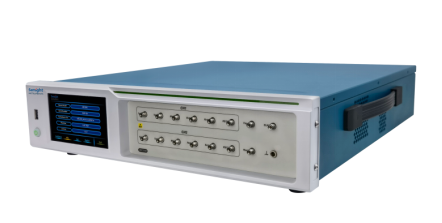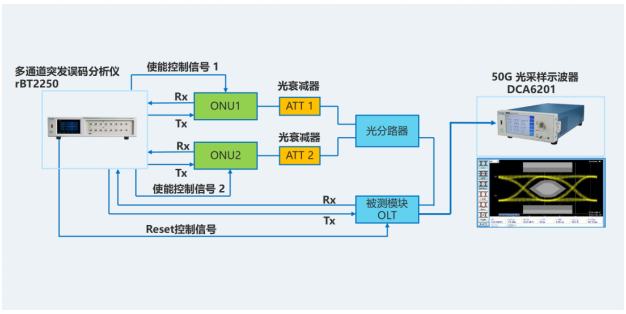 Date:2022.09.30
Visits:913
Date:2022.09.30
Visits:913
Semight Instruments Co., Ltd.
With the deployment and implementation of 10G PON network, the standard of the next generation 50G PON network has also been improved: In 2018, ITU/FSAN started the development of a single wavelength 50G PON standard, named G.HSP (G. Higher Speed PON). In 2019, the overall demand of 50G PON G.9804.1 was released, which defined the single wavelength TDM PON architecture and the combination of uplink and downlink rates. In addition, 50G PON needs to meet the smooth evolution of coexistence with 10G PON and stock ODN. In 2021, ITU-T 50G PON series standards will be officially released, including General Requirements Standard Revision G.9804.1 AMD1, General Protocol Layer Standard G.9804.2, and Physical Layer Standard G.9804.3. In order to meet the testing requirements of the next generation 50G PON, Semight has launched rBT2250, a new burst error rate analyzer for the next generation 25G/50G PON optical line terminal (OLT) testing.

Figure 1 Lianxun rBT2250 25G/50G burst bit error meter
50G PON application scenario
50G PON is a comprehensive improvement of the access network capability, realizing the comprehensive improvement of large bandwidth, low delay guarantee and channelization capability, and is oriented to multiple application scenarios.

Figure 2 Full scene of 50G PON
50G PON uses single fiber bidirectional transmission, downlink TDM time division multiplexing, and uplink TDMA time division multiple access to achieve point to multipoint communication between OLT and ONU. In the PON system, the optical network unit ONU shares an optical line terminal OLT through optical fiber and coupler, and the uplink data transmission uses time division multiplexing to share the uplink channel. For the optical transmitter transmitting uplink data, it transmits burst packet signals. At present, due to the limitation of core chips and devices, 50G PON is still asymmetric at this stage: downlink 50G continuous/uplink 25G burst.

Figure 3 50G PON architecture
50G PON Test Challenge
Due to different transmission paths, each data packet has different attenuation, and there are long "1" and "0" in the data packet. The influence of these factors makes the signal received by the OLT burst reception module a special optical burst signal.

Fig. 4 ONU signals with different amplitudes
ONU uplink burst signal:
Enable control signal synchronized with data is required;
Data packet with time sequence (frame structure) that can send preamble+PRBS data is required
Bit error tester with burst data and synchronization enable control signal is required

Figure 5 Double burst test of burst bit error tester
For uplink burst signals, the OLT receiving module not only needs to quickly recover the signals with equal amplitude from the ONU1 and ONU2 burst signals with different power attenuation, but also needs to eliminate the phase mutation of different ONUs, that is, to complete the clock and phase alignment. Therefore, the signals output by the OLT should be electrical signals with equal amplitude and clock and phase alignment. The dual burst test can simulate the transmission test of two ONUs with different attenuation.
The burst bit error analyzer is required to verify the performance of the OLT receiver in the burst mode. The continuous mode bit error analyzer cannot diagnose the problematic OLT
RBT2250 burst bit error meter
In response to the above test requirements, Lianxun instrument rBT2250 provides two independent burst code generators and error code detector channels, supports continuous mode or burst mode error code analysis, and is capable of generating two burst time code sequences and error code analysis. The code type timing is flexible and adjustable, and the corresponding test channels are provided with synchronous laser enable, reset signal and other low-speed control channels according to the device test requirements. Moreover, the rBT2250 has built-in clock recovery, which can automatically measure distance, and has no problem with long fiber testing. This greatly simplifies test setup, connectivity, floor space, and testing costs.

Figure 6 Main Test Interface of rBT2250 Software
Product features
Support sudden or continuous mode signal output and error code test;
Burst mode support rate: 9.953Gbps/10.3125Gbps/12.4416Gbps/24.8832Gbps;
Multi channel configuration:
Integrate two independent high-speed burst data channels,
Support 2-channel burst timing configurable code generator channel and 1-channel burst error code test channel;
Support 2-way synchronous ONU laser enable control channel, and the control level needs LVTTL 3.3V, without external level conversion;
Support 1 channel of dual reset control channel: the reset position is adjustable, and the reset width is adjustable;
Support 1-way RSSI Trigger: RSSI Trigger position and pulse width can be adjusted;
Additional continuous code generator channels can be added: dual 25G NRZ channels, 50G PAM4 channels or 50G NRZ channels can be selected;
Support LOS measurement: each test channel has its own LOS monitoring channel, which can monitor SD (Signal Detect) signals and judge LOS;
Support CDR (clock recovery): similar to OLT equipment, clock recovery will be performed every time receiving; The built-in clock recovery enables the rBT2250 to work in a real long fiber working environment, which is basically impossible in other schemes commonly used in the industry, because those systems do not support clock recovery, and the impact of the long fiber on delay and jitter makes it unable to work.

Figure 7 Overall Test Scheme of Lianxun 25G OLT
In the overall OLT test scheme, the rBT2250 burst error rate meter supports two burst signals at the same time, simulates the dual packet burst test of two ONUs, and the 50G optical sampling oscilloscope supports the OLT TX terminal continuous mode optogram test.
Service hotline
Follow
Name
Email verfication code
Phone
Password
Confirm Password
e-mail address
Email verification code
New Password
Confirm Password